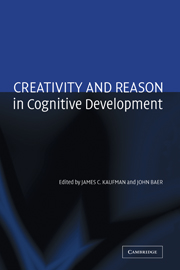Book contents
- Frontmatter
- Contents
- List of Contributors
- Acknowledgments
- Creativity and Reason in Cognitive Development
- Introduction
- COGNITIVE PERSPECTIVES
- DEVELOPMENTAL AND EDUCATIONAL PERSPECTIVES
- 12 Creativity in Young Children's Thought
- 13 A Young Artist's Story: Advancing Knowledge and the Development of Artistic Talent and Creativity in Children
- 14 Is It Reasonable to Be Creative?
- 15 Does Culture Always Matter: For Creativity, Yes, for Deductive Reasoning, No!
- 16 Higher Level Thinking in Gifted Education
- 17 The Relationship Among Schooling, Learning, and Creativity: “All Roads Lead to Creativity” or “You Can't Get There from Here”?
- 18 How Early School Experiences Impact Creativity: An Ecological Perspective
- 19 Conclusions
- Author Index
- Subject Index
- References
18 - How Early School Experiences Impact Creativity: An Ecological Perspective
Published online by Cambridge University Press: 19 January 2010
- Frontmatter
- Contents
- List of Contributors
- Acknowledgments
- Creativity and Reason in Cognitive Development
- Introduction
- COGNITIVE PERSPECTIVES
- DEVELOPMENTAL AND EDUCATIONAL PERSPECTIVES
- 12 Creativity in Young Children's Thought
- 13 A Young Artist's Story: Advancing Knowledge and the Development of Artistic Talent and Creativity in Children
- 14 Is It Reasonable to Be Creative?
- 15 Does Culture Always Matter: For Creativity, Yes, for Deductive Reasoning, No!
- 16 Higher Level Thinking in Gifted Education
- 17 The Relationship Among Schooling, Learning, and Creativity: “All Roads Lead to Creativity” or “You Can't Get There from Here”?
- 18 How Early School Experiences Impact Creativity: An Ecological Perspective
- 19 Conclusions
- Author Index
- Subject Index
- References
Summary
“Play something for me.”
“What do you want me to play?”
“Anything you want! Just whatever comes into your head.”
“Uh … without music? I dunno!”
With encouragement, some children will take the tentative steps necessary to create a song. Younger children who have never taken lessons happily poke at keys, creating an atonal, arrhythmic stream that, by Western standards, would not be considered musically pleasing. Older children take a different tact. After looking rather uncomfortable and somewhat helpless, they play a song that they have been taught by a friend or sibling (such as “Chopsticks” or “100 bottles of beer on the wall”). When I ask for something more “creative,” they most often deny my request, stating that the very reason they have come for lessons is to be taught how to play and what did I expect?
The same task, the same setting, but the younger children are more likely to attack the creative challenge fearlessly. Unaware of harmonic rules, these children seem oblivious to tonality, allowing their creations to include atonal combinations. The older children give a safe, constrained response or ask for direction. Following instruction, the results are no more encouraging. Once taught that a C chord safely goes with a group of notes in C major and then asked to create music, children will play only what they think fits within the C chord structure.
- Type
- Chapter
- Information
- Creativity and Reason in Cognitive Development , pp. 333 - 350Publisher: Cambridge University PressPrint publication year: 2006
References
- 2
- Cited by

